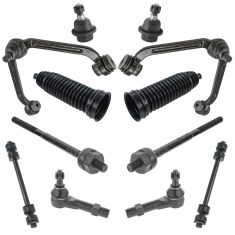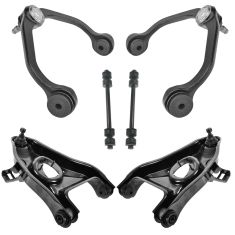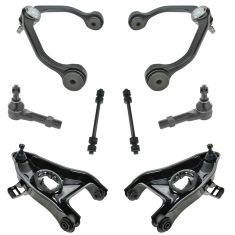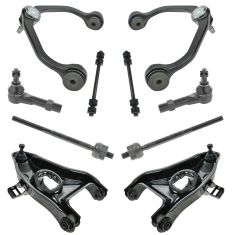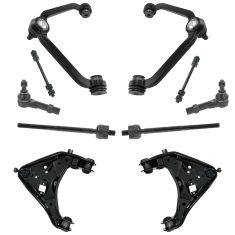1ASFK06331-Ford Mazda Front 12 Piece Steering & Suspension Kit TRQ PSA64939
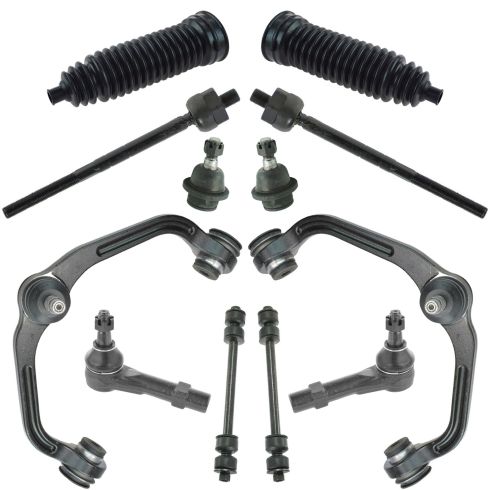
Replaces
2001 Mazda B3000 Truck SE Rear Wheel Drive Front 12 Piece Steering & Suspension Kit TRQ PSA64939

Product Reviews
Loading reviews
4.72/ 5.0
18
18 reviews
Nice kit- All parts needed included for front-end overhaul
June 15, 2020
Parts are great quality- they look and feel much better than stock. Designed to hold up better and less rust and seized bolts. Great product to get the job done.
Great Prices!
August 7, 2020
I bought a front end steering and suspension kit for my 2002 Ford Ranger. The price was great and everything was a great fit. I couldn't be more pleased!
Wish I could but they got stolen
September 14, 2020
fast delivery looked good n every thing was there but one problem had in back of my truck with cammper top on it i stop at mechanic n was walking back out to my truck n half to it n someone drove off in it still no word bout the truck but like i said fast delivery n parts looked good n every thing there will sjop with hoh guys again
Front End rebuild Kit
October 11, 2020
The kit was flawless in design. All Parts Fit as they should.
Reason for 4 stars is wish the kit came with a toque sheet.
Reasonable prices, Fast shipping
December 1, 2020
I inherited a 99 Ford Ranger with less than 150,000 miles on it but the truck had been sitting for the majority of its life. The bushings and seals on everything in the front end had apparently dry rotted and cracked apart during that time sitting. I just ordered the front end kit instead of trying to just replace seals. 1A auto always has what I need at extremely reasonable prices. Will definitely buy again from them.
Great
January 20, 2021
Fit great. 05 Ranger. Good sturdy parts. Well see how it holds up.
June 18, 2021
All parts fit as advertised. I would have liked if all the parts had grease fittings.
Great products
July 19, 2021
Shipping was fast.
All front end parts fit accordingly. no problems during installation.
Would definitely recommend.
November 23, 2021
Great all my parts fit and arrived fast
March 1, 2022
Fits good, quality product!
They got it half right
April 17, 2022
Control arm didn't fit and one tie rod end was not threaded.
Very satisfied
December 3, 2022
Turned out really great, took me about two days at a relaxed pace to get both sides and some other things done. My ride feels like its a new truck and not one with 100,000+ miles on it. I hope the parts hold up to the rest of time.
Exceeded Expectations
June 10, 2023
Needed this 'on the fly' to repair hubby's Ford Ranger before he got home from overseas. Arrived ahead of schedule. Great price, great fitment, easy install - what more could you ask for? Shop I went to for wheel alignment after install gave the quality a two thumbs up. It's only been about 6 wks, but his ride feels great and so far has exceeded expectations.
Thank you!
August 18, 2023
I'm happy with the outcome after installing these parts. Will be coming back for other vehicle needs.
October 24, 2023
Worked great, Came quick, My error and was great to work with and get corrected.
Suspension kit.
February 17, 2024
The kit was a direct replacement and went on with ease. There was a mix up in parts sent to me but the customer service was very quick and responsive in order to get the problem solved. Very happy with the experience at 1A auto.
April 13, 2024
Fit very good
Fit
April 17, 2024
Everything came complete nothing wrong perfect fit zero complaints
Customer Q&A
are the new ball joints greaeable ?
June 11, 2021
10
No
June 11, 2021
Anthony D
10
No
June 12, 2021
R E
10
The ball joints will be pregreased and sealed.
June 14, 2021
Jessica D
Will this work with 4x4?
June 16, 2021
10
This is only able to fit for vehicles with rear wheel drive.
June 16, 2021
Emma F
Will this kit work with the edge model ?
April 6, 2022
10
We cannot verify this as we do not have your exact vehicle information. Be sure to verify all of the information shown in the Vehicle Fit tab before ordering.
April 6, 2022
Cristina P
10
No, does not work with torsion bar front end.
April 17, 2022
Ken A
Does this fit 2011 does ranger xlt 2 wheel drive?
June 22, 2023
10
This will fit your vehicle if it has Front Coil Spring Suspension.
June 22, 2023
Andra M
Mazda is a registered trademark of Mazda Motor Corporation. 1A Auto is not affiliated with or sponsored by Mazda or Mazda Motor Corporation.
See all trademarks.















